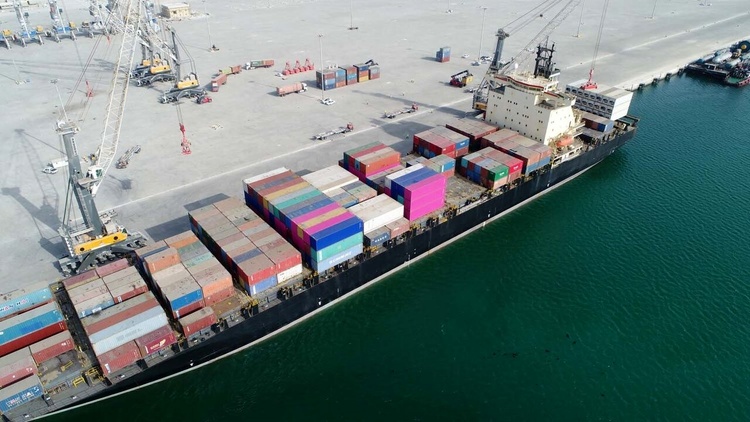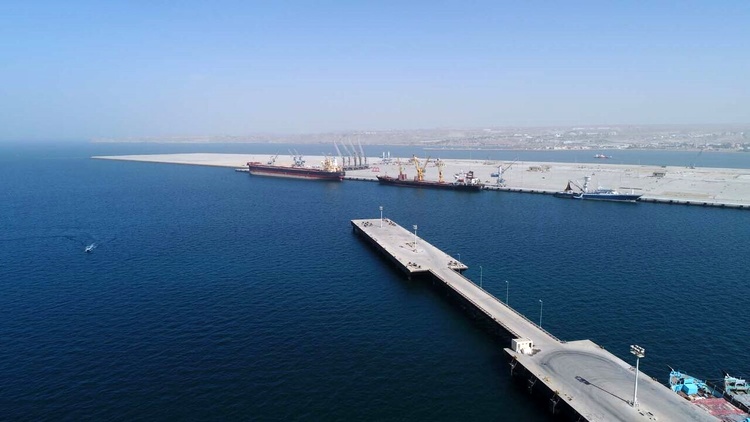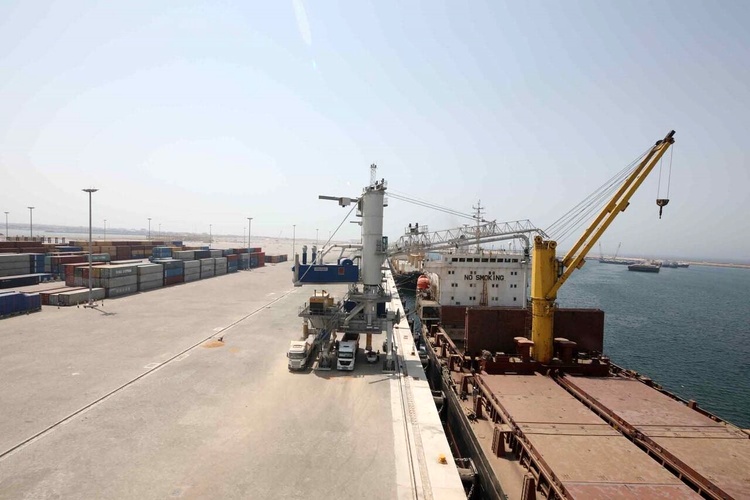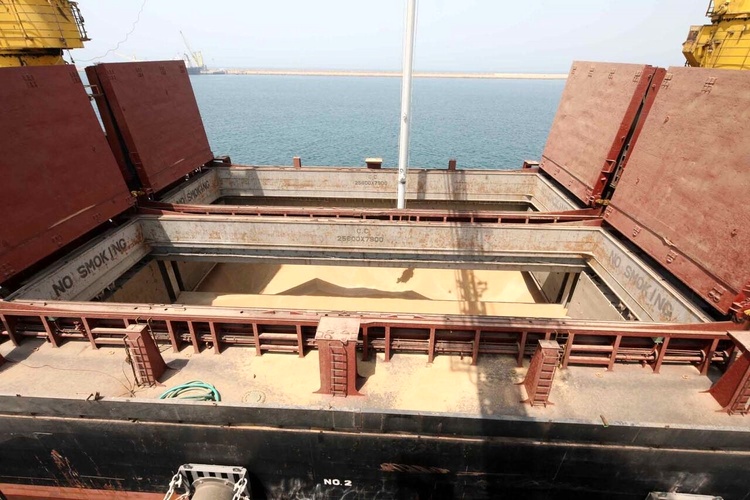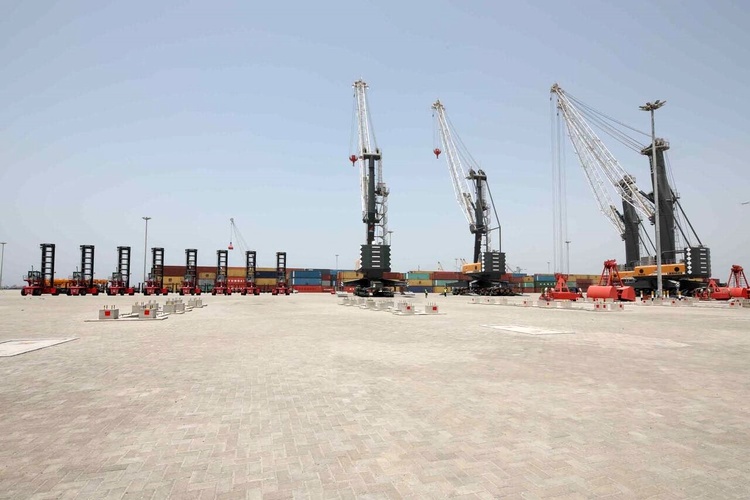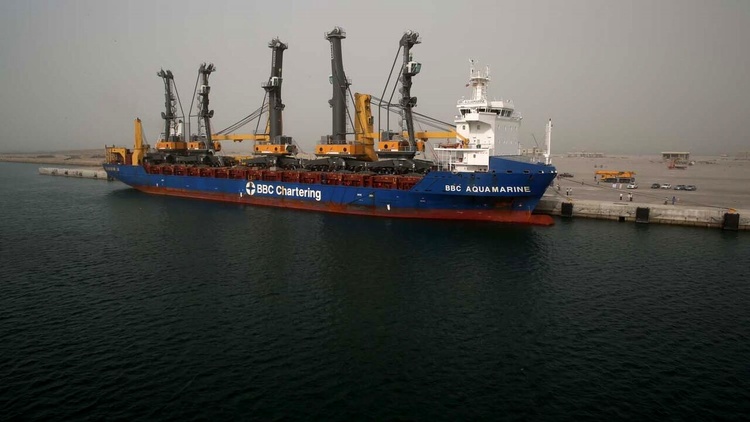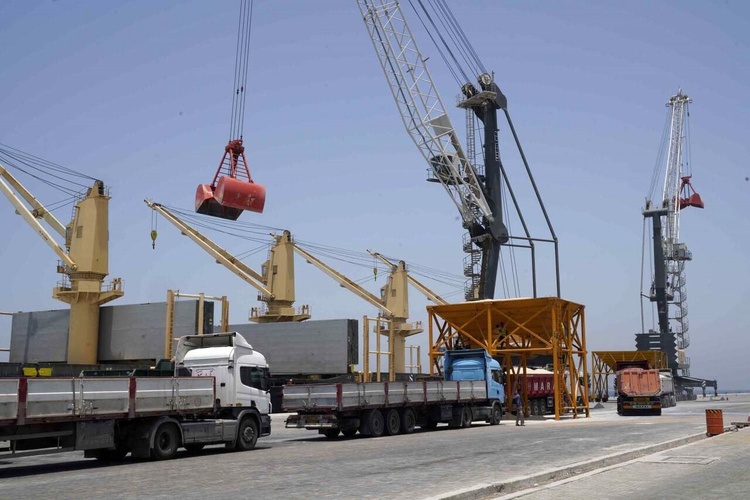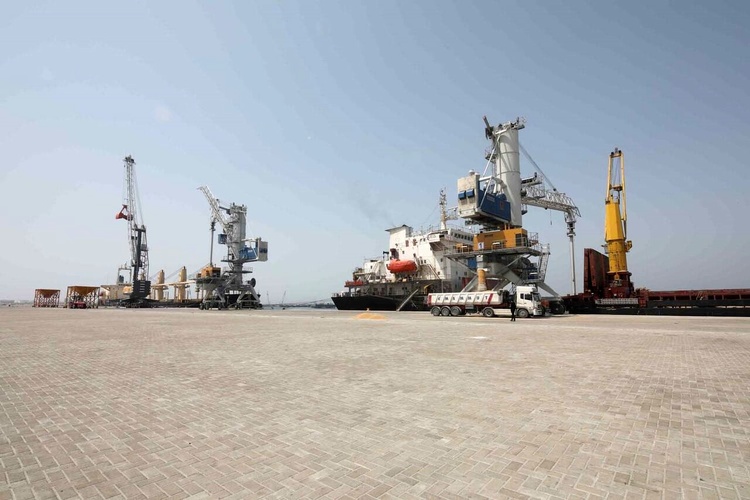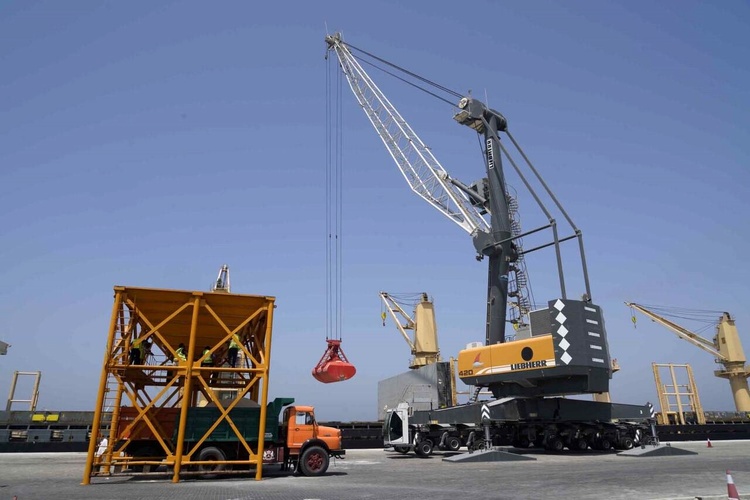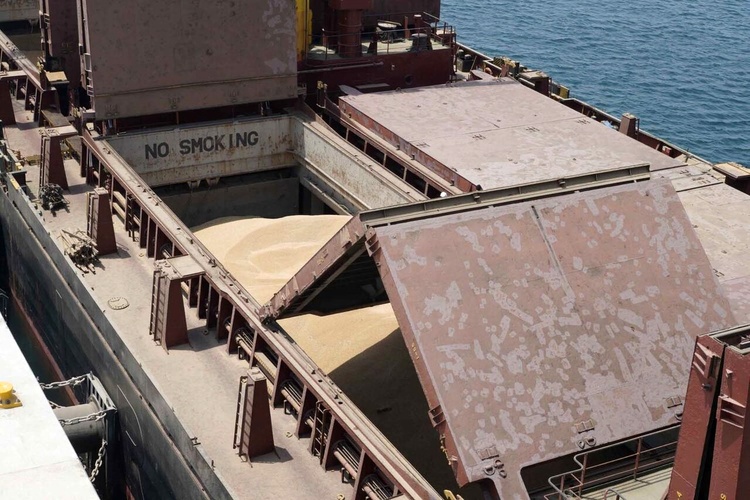How to install the app on iOS
Follow along with the video below to see how to install our site as a web app on your home screen.
Note: This feature may not be available in some browsers.
You are using an out of date browser. It may not display this or other websites correctly.
You should upgrade or use an alternative browser.
You should upgrade or use an alternative browser.
[PIC/VID] Chabahar port
- Thread starter SubWater
- Start date
TheImmortal
SENIOR MEMBER

- Joined
- Mar 11, 2017
- Messages
- 7,091
- Reaction score
- -12
- Country
- Location
A disgrace given that Chabahar port was supposed to be started in 1970’s.
At this rate my great grandchildren will be talking about the ongoing construction there.
At this rate my great grandchildren will be talking about the ongoing construction there.
aryobarzan
SENIOR MEMBER

- Joined
- Feb 17, 2019
- Messages
- 4,586
- Reaction score
- 1
- Country
- Location
Russian are becoming interested in this port...This port is significant because it is not in the Persian gulf so it will be Iran's gateway in case iran decides to close off the Persian gulf to all traffic (which they can) . One billion dollar investment done so far is not small change for a port for a country under sanctions. There is a beautiful university and its campus in this port


SubWater
SENIOR MEMBER

- Joined
- Jan 6, 2017
- Messages
- 3,245
- Reaction score
- -8
- Country
- Location
Iran mulling discounts to encourage more operations at Chabahar port
Thu Aug 22, 2019 04:19PM [Updated: Thu Aug 22, 2019 05:06PM ]

Harbor security men stand guard during an inauguration ceremony of new equipment and infrastructure at Shahid Beheshti area in the Southeastern Iranian port city of Chabahar, on the Sea of Oman on February 25, 2019. (AFP photo)
Iranian government is planning discounts along other measures to encourage increased port operations in Chabahar southeast of the country.
Iran’s deputy minister of commerce said on Thursday that the government was doing follow-ups on a promise to grant a 30-percent discount on customs duties for cargoes unloaded at Shahdi Beheshti area of the port of Chabahar.
Hossein Modarress Khiabani said that the government had also made it mandatory for two major state-run companies to unload and transport their import cargoes via the facilities at Shahid Beheshti area rather than their traditional destination at Imam Khomeini Port in southwest Iran.
The measures come amid reports that Iran has expedited efforts to increase activity in Chabahar after India, a major partner for the development of the port city, said it was unhappy with the slow progress made to turn the port into a major shipping and trade hub in the region.
India has signed major agreements with Iran to build two terminals at Shahid Beheshti area and a railway connecting Chabahar to the city of Zahedan near the Afghan border as it seeks easier trade access to Afghanistan and countries in the central Asia region.

PressTV-MP rejects reports on Russia’s takeover of Iranian port
An Iranian lawmaker says reports on Russia’s imminent takeover of Chabahar port are untrue.
The development programs, however, hit a snag last year after the US imposed a new round of sanctions on Iran over the country’s nuclear activities.
Iran’s transportation minister said earlier this month that Tehran had accelerated construction activities at its section of Chabahar-Zahedan railway.
Measures adopted for increased port operations at Chabahar also come a week after Iranian authorities denied media reports that they were seeking to replace Russia with India in the development plans for the port.
https://www.presstv.com/Detail/2019/08/22/604205/Iran-plans-increased-operations--Chabahar-port
Thu Aug 22, 2019 04:19PM [Updated: Thu Aug 22, 2019 05:06PM ]

Harbor security men stand guard during an inauguration ceremony of new equipment and infrastructure at Shahid Beheshti area in the Southeastern Iranian port city of Chabahar, on the Sea of Oman on February 25, 2019. (AFP photo)
Iranian government is planning discounts along other measures to encourage increased port operations in Chabahar southeast of the country.
Iran’s deputy minister of commerce said on Thursday that the government was doing follow-ups on a promise to grant a 30-percent discount on customs duties for cargoes unloaded at Shahdi Beheshti area of the port of Chabahar.
Hossein Modarress Khiabani said that the government had also made it mandatory for two major state-run companies to unload and transport their import cargoes via the facilities at Shahid Beheshti area rather than their traditional destination at Imam Khomeini Port in southwest Iran.
The measures come amid reports that Iran has expedited efforts to increase activity in Chabahar after India, a major partner for the development of the port city, said it was unhappy with the slow progress made to turn the port into a major shipping and trade hub in the region.
India has signed major agreements with Iran to build two terminals at Shahid Beheshti area and a railway connecting Chabahar to the city of Zahedan near the Afghan border as it seeks easier trade access to Afghanistan and countries in the central Asia region.

PressTV-MP rejects reports on Russia’s takeover of Iranian port
An Iranian lawmaker says reports on Russia’s imminent takeover of Chabahar port are untrue.
The development programs, however, hit a snag last year after the US imposed a new round of sanctions on Iran over the country’s nuclear activities.
Iran’s transportation minister said earlier this month that Tehran had accelerated construction activities at its section of Chabahar-Zahedan railway.
Measures adopted for increased port operations at Chabahar also come a week after Iranian authorities denied media reports that they were seeking to replace Russia with India in the development plans for the port.
https://www.presstv.com/Detail/2019/08/22/604205/Iran-plans-increased-operations--Chabahar-port
vi-va
SENIOR MEMBER

- Joined
- Jan 23, 2019
- Messages
- 6,475
- Reaction score
- 3
- Country
- Location
With all my respect to Iranians, I disagree one of your statement.Russian are becoming interested in this port...This port is significant because it is not in the Persian gulf so it will be Iran's gateway in case iran decides to close off the Persian gulf to all traffic (which they can) . One billion dollar investment done so far is not small change for a port for a country under sanctions. There is a beautiful university and its campus in this port View attachment 575113 View attachment 575114
Chabahar port is in good location and has strategic value, that I totally agree. But the moment you close Strait of Hormuz, you literally choose war. Chabahar port can't operate as normal during war time, too close to Strait of Hormuz.
Turingsage
BANNED

- Joined
- Sep 28, 2014
- Messages
- 2,304
- Reaction score
- -23
- Country
- Location
Excellent . Looks tremendous. I hope Indian/Iranian students study side by side at the University. Looks far far better and populated and busy compared to any other nearby port.
To paraphrase Mao let a thousand road and rail links bloom at Chabahar
Building that vital rail link Chabahar to Shahr and Zahedan

To paraphrase Mao let a thousand road and rail links bloom at Chabahar
Building that vital rail link Chabahar to Shahr and Zahedan

Sineva
SENIOR MEMBER

- Joined
- May 24, 2018
- Messages
- 4,657
- Reaction score
- -2
- Country
- Location
WOW!!,it doesnt look like the indians have done very much at all.....Still thats not very surprising,I think india sees its future these days as one of hindu fascism....sorry "nationalism" and american vassalage.Just imagine what the chinese could`ve done by now.
A very good article on the failure of indias chabahar dreams:
https://www.bourseandbazaar.com/art...iran-port-plans-languish-despite-us-exemption
India’s Iran Port Plans Languish Despite US Waiver
A year has passed since the US reimposed sanctions on Iran. During this time, the Trump administration exempted India’s investments in the Iranian port of Chabahar from sanctions in order to protect India’s strategic interests. Despite this accommodation, recent government data suggests that no new Indian investments have been made in the port project in the last two years.
Foreign aid expenditure figures released in July by the re-elected Modi government show that India has not spent any of its allocated funds for Chabahar since 2017. There is a conspicuous absence of spending even though roughly USD 20 million (150 crore rupees) was set aside each year. The government has now allocated a significantly lower, and perhaps more realistic, USD 6 million for the current year.
These figures confirm reports that India’s ambitions for Chabahar had hit a stumbling block even before Trump withdrew from the JCPOA nuclear deal. Evidently, the sanctions waiver has not been of much use either.
India’s Chabahar Ambitions
Indian prime minister Narendra Modi, now in his second term, has declared regional connectivity as a primary foreign policy goal and injected momentum into major initiatives to India’s east and west. A part of this was certainly driven by the state’s concerns about China’s own mammoth connectivity drive—the Belt and Road Initiative (BRI)—that runs through its immediate neighborhood and traditional sphere of influence. The project ideas themselves, however, pre-date the BRI.
The main regional connectivity project to India’s west is the Iran-India-Afghanistan transit initiative that hinges on the development of the Chabahar port along with road and rail links connecting it to Afghanistan. With Pakistan denying land access to India, New Delhi intends to use Chabahar to engage with the Afghan market and support Afghanistan’s trade and economic development.
Four years after Modi injected fresh momentum into the project, development at Chabahar has been slow—largely owing to US sanctions against Iran.
As per Iran’s original four-phase development plan, India was to invest USD 85 million to upgrade, equip, and operate two terminals on a ten-year lease. Indian prime minister Narendra Modi and Iranian President Hassan Rouhani oversaw the signing of this contract in May 2016 during the former’s visit to Iran.
Subsequently, Iran upgraded existing port infrastructure as per their agreed first phase of development. This upgraded port was inaugurated in December 2017 with great fanfare. The following year, India took over operations of the port but not much else went according to plan.
Ambitions vs. Reality
When it comes to sanctions, talk is never cheap.
Statements are more than enough to spook companies, heighten risk-aversion, and add further costs to proposed ventures. This was the case for Chabahar as early as Trump’s election campaign, long before the US president violated the nuclear deal.
The Indians first faced an investment chill at home. The Chabahar project calls for a private Indian firm to come on board as a strategic partner to manage, operate and maintain the port for ten years. The government entity created to oversee India’s foreign port projects—India Global Ports Limited (IGPL)—held two bidding rounds since 2016 with no result. It is now rewriting the terms a third time. Given the delay, the Indians signed on an Iranian firm (Kaveh Port and Marine Services) in the interim to take over operations.
A second task was to equip the port. European firms were Iran’s first preference but predictably after Trump’s win, they showed little-to-no interest in equipment bids. This left India with no choice but to work with Chinese firms. Interestingly, a Chinese company that won a bid to supply cranes in 2017 is blacklisted within India. Recent reports in the Indian media now suggest that some of these companies are reluctant to deliver equipment. Again, an environment of fear and uncertainty remains despite the US exemption.
A third aspect is the larger regional project on connectivity between India, Iran, and Afghanistan. As things stand, all parties are working with existing port infrastructure, roadways and operational capacity on this transit project. The route was tested successfully in October 2017 when Indian shipments of wheat arrived at Chabahar from Kandla (Gujarat) and made their way into Afghanistan. There is much left to be done, including the building of a new railway route, but Trump’s sector-specific sanctions pose new complications.
Making Do and Muddling Through
Three years on, Chabahar’s progress does not match India’s original expectations and Trump’s exemption has proven to be inadequate.
This project was touted to be India’s first foreign port development endeavour. For many assessing New Delhi’s record on infrastructure development abroad, the Chabahar project is no longer a useful indicator. It continues to rely heavily on stopgap measures with neither Indian nor foreign companies coming on board. It was a venture that New Delhi could have fought harder to preserve. But the reality is that it chose not to—a decision that merits an entirely separate discussion on the nuances of the India-US partnership and Iran’s reduced place in it.
All signs today point to the stakeholders behind the Chabahar project muddling through with what exists on the ground in Iran. As one Indian official involved with the project since its origins lamented, “This was not what we hoped to achieve. Chabahar is only about photo-ops now, not substance.”
A very good article on the failure of indias chabahar dreams:
https://www.bourseandbazaar.com/art...iran-port-plans-languish-despite-us-exemption
India’s Iran Port Plans Languish Despite US Waiver
A year has passed since the US reimposed sanctions on Iran. During this time, the Trump administration exempted India’s investments in the Iranian port of Chabahar from sanctions in order to protect India’s strategic interests. Despite this accommodation, recent government data suggests that no new Indian investments have been made in the port project in the last two years.
Foreign aid expenditure figures released in July by the re-elected Modi government show that India has not spent any of its allocated funds for Chabahar since 2017. There is a conspicuous absence of spending even though roughly USD 20 million (150 crore rupees) was set aside each year. The government has now allocated a significantly lower, and perhaps more realistic, USD 6 million for the current year.
These figures confirm reports that India’s ambitions for Chabahar had hit a stumbling block even before Trump withdrew from the JCPOA nuclear deal. Evidently, the sanctions waiver has not been of much use either.
India’s Chabahar Ambitions
Indian prime minister Narendra Modi, now in his second term, has declared regional connectivity as a primary foreign policy goal and injected momentum into major initiatives to India’s east and west. A part of this was certainly driven by the state’s concerns about China’s own mammoth connectivity drive—the Belt and Road Initiative (BRI)—that runs through its immediate neighborhood and traditional sphere of influence. The project ideas themselves, however, pre-date the BRI.
The main regional connectivity project to India’s west is the Iran-India-Afghanistan transit initiative that hinges on the development of the Chabahar port along with road and rail links connecting it to Afghanistan. With Pakistan denying land access to India, New Delhi intends to use Chabahar to engage with the Afghan market and support Afghanistan’s trade and economic development.
Four years after Modi injected fresh momentum into the project, development at Chabahar has been slow—largely owing to US sanctions against Iran.
As per Iran’s original four-phase development plan, India was to invest USD 85 million to upgrade, equip, and operate two terminals on a ten-year lease. Indian prime minister Narendra Modi and Iranian President Hassan Rouhani oversaw the signing of this contract in May 2016 during the former’s visit to Iran.
Subsequently, Iran upgraded existing port infrastructure as per their agreed first phase of development. This upgraded port was inaugurated in December 2017 with great fanfare. The following year, India took over operations of the port but not much else went according to plan.
Ambitions vs. Reality
When it comes to sanctions, talk is never cheap.
Statements are more than enough to spook companies, heighten risk-aversion, and add further costs to proposed ventures. This was the case for Chabahar as early as Trump’s election campaign, long before the US president violated the nuclear deal.
The Indians first faced an investment chill at home. The Chabahar project calls for a private Indian firm to come on board as a strategic partner to manage, operate and maintain the port for ten years. The government entity created to oversee India’s foreign port projects—India Global Ports Limited (IGPL)—held two bidding rounds since 2016 with no result. It is now rewriting the terms a third time. Given the delay, the Indians signed on an Iranian firm (Kaveh Port and Marine Services) in the interim to take over operations.
A second task was to equip the port. European firms were Iran’s first preference but predictably after Trump’s win, they showed little-to-no interest in equipment bids. This left India with no choice but to work with Chinese firms. Interestingly, a Chinese company that won a bid to supply cranes in 2017 is blacklisted within India. Recent reports in the Indian media now suggest that some of these companies are reluctant to deliver equipment. Again, an environment of fear and uncertainty remains despite the US exemption.
A third aspect is the larger regional project on connectivity between India, Iran, and Afghanistan. As things stand, all parties are working with existing port infrastructure, roadways and operational capacity on this transit project. The route was tested successfully in October 2017 when Indian shipments of wheat arrived at Chabahar from Kandla (Gujarat) and made their way into Afghanistan. There is much left to be done, including the building of a new railway route, but Trump’s sector-specific sanctions pose new complications.
Making Do and Muddling Through
Three years on, Chabahar’s progress does not match India’s original expectations and Trump’s exemption has proven to be inadequate.
This project was touted to be India’s first foreign port development endeavour. For many assessing New Delhi’s record on infrastructure development abroad, the Chabahar project is no longer a useful indicator. It continues to rely heavily on stopgap measures with neither Indian nor foreign companies coming on board. It was a venture that New Delhi could have fought harder to preserve. But the reality is that it chose not to—a decision that merits an entirely separate discussion on the nuances of the India-US partnership and Iran’s reduced place in it.
All signs today point to the stakeholders behind the Chabahar project muddling through with what exists on the ground in Iran. As one Indian official involved with the project since its origins lamented, “This was not what we hoped to achieve. Chabahar is only about photo-ops now, not substance.”
Similar threads
- Replies
- 1
- Views
- 865
- Replies
- 691
- Views
- 58K
- Replies
- 4
- Views
- 1K
- Replies
- 21
- Views
- 3K
Latest posts
-
-
-
Argentina Considering To Purchase 12 JF17C Worth 664Million Dollars
- Latest: FourMikeEcho
-
-
Pakistan Affairs Latest Posts
-
Pakistan military officer sues Adil Raja for defamation in unprecedented UK action
- Latest: muhammadhafeezmalik
-

